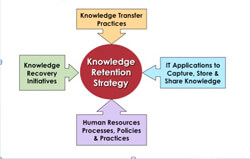 Is your organization living on the edge? Does the loss of vital know-how or failure to document and transfer essential capabilities threaten to:
Is your organization living on the edge? Does the loss of vital know-how or failure to document and transfer essential capabilities threaten to:
Expose critical points of failure?
The expertise needed to maintain special valves for a major chemical company dissipated quickly when some key veterans retired and training wasn’t increased. Top management only became aware maintenance capabilities had declined when an explosion in one of the firm’s plants was attributed to a faulty valve that had just been serviced.
Limit your organization’s growth?
A global medical products firm was committed to roll out a new heart valve device in the next year, but it had to find a way to capture and scale the critical knowledge its small group of clinical specialists had developed during the product’s clinical trials. Getting dozens of newly-hired clinical specialists trained to communicate knowledge about a sophisticated heart valve would be key to meeting revenue targets for the new product.
Reduce innovation and slow new product launches?
A consumer products company whose innovation strategy depends on bringing new products to market on time can’t meet these objectives because it doesn’t anticipate the impact of losing the expertise of veteran research scientists or product development engineers.
Increase costs by reducing the efficiency and quality of your operations?
A plant manager in the food processing industry suddenly sees both quality defects and machine downtime increase when a veteran process technician retires. His OEE budget is shot.
Many organizations today are suffering from the costs of knowledge loss, due to increased Baby Boomer retirements and unexpected mid-career turnover. Here are three things you can do to reduce these negative impacts on the bottom line:
1. Set Priorities: Make hard calls about where to apply resources.
In reality, there’s a lot more know-how in your organization that would be useful to capture and reuse than you can possibly handle. Do you know specifically what your knowledge capture and transfer priorities are? Where do retirements, the need to scale operations, or the risk of a costly accident make knowledge retention most pressing.
We use a tool called a “Knowledge Silo Matrix” to help clients quickly identify core knowledge domains and to evaluate the sustainability of capabilities in each area. We’ve used this tool with large engineering groups in power plants, association management companies, non-profits, community hospitals, fast growing software firms, and midsize manufacturing plants. The need to identify and prioritize specific knowledge at risk is a common, but widely ignored, problem.
2. Provide Tools & Techniques for Sharing: Create an effective process to maximize knowledge transfer.
There are three things you need to do to create a more effective knowledge transfer process. First, help your subject matter experts articulate what they know.
We use a structured interviewing process called a “Skill Development Plan,” which was developed by my co-author Steve Trautman. This highly practical tool defines essential tasks that can readily be taught to successors moving into a role, whether it’s an aeronautical engineer, a hospital lab point of care coordinator, or an association program manager.
Second, improve your employees mentoring abilities. Anybody who’s been to college knows there are plenty of experts who can’t teach. They’re sometimes called professors! (Of course, there are lots of fabulous teachers in higher education, hold the hate mail.) Unfortunately, being an expert in something doesn’t mean you can teach it. To improve knowledge transfer, you’ve got to make sure your employees have the core skills needed to pass on their knowledge.
Third, address the motivational obstacles that can undermine knowledge sharing. Veteran workers suddenly asked to pass on their know-how are very likely to assume they are about to be forced out of the organization. Other overworked employees may resent taking on the added burden of training less experienced colleagues, especially if there is no acknowledgement or reward for their extra effort. Identifying and addressing these motivational potholes directly is essential to keeping knowledge transfer efforts on track.
3. Think Big! Take a more systemic view of your knowledge transfer practices.
 Sustaining critical capabilities long term is more than just giving experienced employees tools to share their knowledge and the incentive to do it. Leaders need to align the organization’s human resource policies, information technology infrastructure, and practices for recovering or reinventing knowledge that has left the organization. My book “Lost Knowledge: Confronting the Threat of an Aging Workforce” provides a framework for thinking more strategically about solutions to this problem.
Sustaining critical capabilities long term is more than just giving experienced employees tools to share their knowledge and the incentive to do it. Leaders need to align the organization’s human resource policies, information technology infrastructure, and practices for recovering or reinventing knowledge that has left the organization. My book “Lost Knowledge: Confronting the Threat of an Aging Workforce” provides a framework for thinking more strategically about solutions to this problem.
Knowledge sharing tools and practices are always used in a cultural context heavily influenced by human resource processes, IT infrastructure, and knowledge recovery efforts. Minimizing the costs of knowledge loss for the organization over time means taking all of these into account.
Retaining and transferring critical knowledge and capabilities will only become more important as experienced Baby Boomers start to retire in bigger numbers. When organizations function with leaner and more highly skilled teams, the need to explicitly address how essential capabilities and know-how will be sustained through inevitable turnover is key to limiting major quality disruptions and maximizing performance.
Have you experienced knowledge loss that has hurt performance? What practices have you tried to improve knowledge transfer? Tell us what you learned. And contact me if you want to stop worrying about the risks of knowledge loss.
